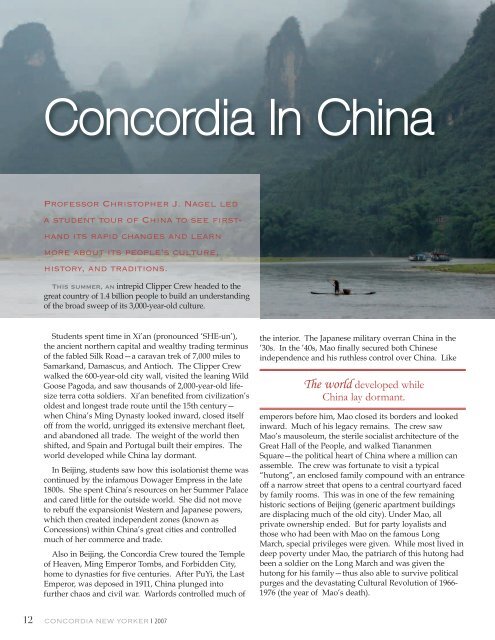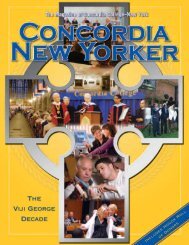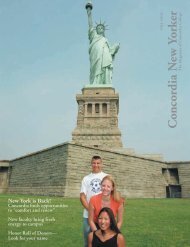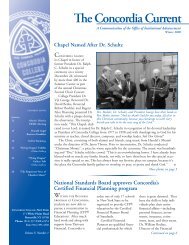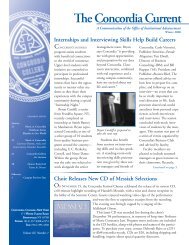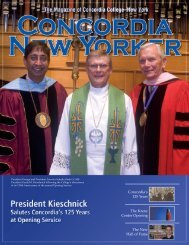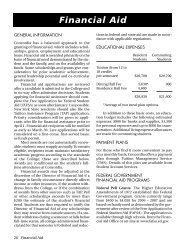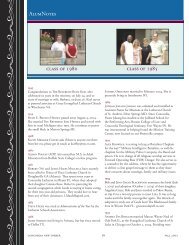Includes HonorRoll ofDonors - Concordia College
Includes HonorRoll ofDonors - Concordia College
Includes HonorRoll ofDonors - Concordia College
You also want an ePaper? Increase the reach of your titles
YUMPU automatically turns print PDFs into web optimized ePapers that Google loves.
<strong>Concordia</strong> In China<br />
Professor Christopher J. Nagel led<br />
a student tour of China to see firsthand<br />
its rapid changes and learn<br />
more about its people’s culture,<br />
history, and traditions.<br />
This summer, an intrepid Clipper Crew headed to the<br />
great country of 1.4 billion people to build an understanding<br />
of the broad sweep of its 3,000-year-old culture.<br />
Students spent time in Xi’an (pronounced ‘SHE-un’),<br />
the ancient northern capital and wealthy trading terminus<br />
of the fabled Silk Road—a caravan trek of 7,000 miles to<br />
Samarkand, Damascus, and Antioch. The Clipper Crew<br />
walked the 600-year-old city wall, visited the leaning Wild<br />
Goose Pagoda, and saw thousands of 2,000-year-old lifesize<br />
terra cotta soldiers. Xi’an benefited from civilization’s<br />
oldest and longest trade route until the 15th century—<br />
when China’s Ming Dynasty looked inward, closed itself<br />
off from the world, unrigged its extensive merchant fleet,<br />
and abandoned all trade. The weight of the world then<br />
shifted, and Spain and Portugal built their empires. The<br />
world developed while China lay dormant.<br />
In Beijing, students saw how this isolationist theme was<br />
continued by the infamous Dowager Empress in the late<br />
1800s. She spent China’s resources on her Summer Palace<br />
and cared little for the outside world. She did not move<br />
to rebuff the expansionist Western and Japanese powers,<br />
which then created independent zones (known as<br />
Concessions) within China’s great cities and controlled<br />
much of her commerce and trade.<br />
Also in Beijing, the <strong>Concordia</strong> Crew toured the Temple<br />
of Heaven, Ming Emperor Tombs, and Forbidden City,<br />
home to dynasties for five centuries. After PuYi, the Last<br />
Emperor, was deposed in 1911, China plunged into<br />
further chaos and civil war. Warlords controlled much of<br />
12 CONCORDIA NEW YORKER | 2007<br />
the interior. The Japanese military overran China in the<br />
’30s. In the ’40s, Mao finally secured both Chinese<br />
independence and his ruthless control over China. Like<br />
The world developed while<br />
China lay dormant.<br />
emperors before him, Mao closed its borders and looked<br />
inward. Much of his legacy remains. The crew saw<br />
Mao’s mausoleum, the sterile socialist architecture of the<br />
Great Hall of the People, and walked Tiananmen<br />
Square—the political heart of China where a million can<br />
assemble. The crew was fortunate to visit a typical<br />
“hutong”, an enclosed family compound with an entrance<br />
off a narrow street that opens to a central courtyard faced<br />
by family rooms. This was in one of the few remaining<br />
historic sections of Beijing (generic apartment buildings<br />
are displacing much of the old city). Under Mao, all<br />
private ownership ended. But for party loyalists and<br />
those who had been with Mao on the famous Long<br />
March, special privileges were given. While most lived in<br />
deep poverty under Mao, the patriarch of this hutong had<br />
been a soldier on the Long March and was given the<br />
hutong for his family—thus also able to survive political<br />
purges and the devastating Cultural Revolution of 1966-<br />
1976 (the year of Mao’s death).


